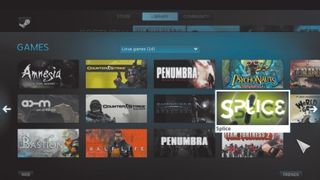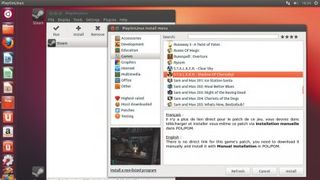Steam for Linux is an ambitious project, as it's attempting to bring native Linux games to the Steam platform. The success of which seems rather limited, with around 55 games - minus demos and expansions packs - currently converted, the majority of which were already natively available on Linux.
Even Valve itself is hardly churning out the titles. It's main, and only, triple-A title for Linux is Team Fortress 2, and while it does run on the Source engine it's still a six-year-old game. The three other games from Valve are the original Half-Life and original Counter-Strike, both of which are nigh on 15-years old. Counter Strike: Source was added on 6 February 2013.
But the major benefit of having Steam on Linux, if you're already a Steam user, is that any game you bought on Windows will still be available. So it's likely you'll have at least one copy of FTL, Amnesia, Killing Floor, World of Goo, Defcon or Darwinia on your books. It keeps your library and the community elements of Steam that you know and love, but brings them to an open OS that you can install on anything.
Steaming ahead

That brings us on to the mysterious Steam Box from Valve. Little is really known about the project at this point, though Gabe Newell did talk about it a little at CES 2013, where Valve was holding closed-door discussions with up to 20 potential hardware partners.
From what was said, we do know that a Valve 'Steam Box' is going to be running Linux and likely be released in 2014. It'll be a small-box PC without an optical drive, and it should have the capability of driving remote screens around the home. It sounds like the base system could even be a smart-streaming box, using the processing power of your main PC to do the 3D donkey work, while extending the HDMI output to your HDTV.
It will, of course, run Steam in its Big Picture mode, providing access to your account, chat and games library. It's open in as much as it's a standard PC that other manufacturers can produce, but whether you'll be able to run standard Linux programs and how exposed the OS will be is unknown. Valve is also offering productivity software via Steam, so that might circumvent that issue to a degree.
You need to realise that Steam as an online gaming distribution platform is huge. Steam accounted for at least 50 per cent of the $4 billion worth online sales in 2011, and estimates go as far as 75 per cent. The huge disparity is no one knows how much money Valve actually makes, but we can imagine it's a pretty penny.
Get daily insight, inspiration and deals in your inbox
Get the hottest deals available in your inbox plus news, reviews, opinion, analysis and more from the TechRadar team.
With all that muscle, could Valve really walk in with a Linux-based console and proclaim "Start making games!" and expect companies to do just that? Or indeed to re-engineer their entire back catalogue to run natively on Linux? All the while, expecting a gaming community to drop their PCs and pick one up? Surely there's a better way?
Wining away

There is another way and that's using Wine, a recursive acronym that proves how clever everyone is, standing for Wine Is Not an Emulator - an acronym that makes a very good point.
An emulator seeks to mimic the original runtime hardware and software environment by translating the code to run on an entirely new system. Wine does no such thing - it redirects system calls to suitable alternative Linux-based ones, all running directly on the native x86 processor.
An alternative name would be a wrapper, the like of which was used for the DirectX version of Half-Life. At the time it was an OpenGL-developed game based on the Quake engine. To enable a DirectX compatible version, the most elegant solution was to create a wrapper that would translate OpenGL calls into DirectX ones, with almost no slow down or side-effects.
